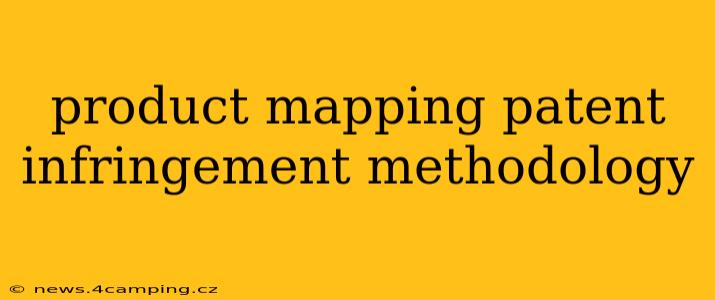Patent infringement is a complex legal issue, particularly when it comes to products with multiple components and functionalities. A robust methodology is crucial for effectively assessing the risk of infringement. Product mapping provides a structured approach to analyze a product's features and compare them to the claims of a patent. This guide outlines a comprehensive methodology for product mapping in the context of patent infringement analysis.
What is Product Mapping in Patent Infringement?
Product mapping is a systematic process of visually representing a product's components and functionalities. This visual representation is then compared to the claims of a potentially infringed patent to determine whether the product's features fall within the scope of the patent's protection. It's essentially a detailed breakdown of your product, allowing for a point-by-point comparison with the patented invention. This allows for a more accurate and defensible assessment of infringement risk.
Steps in the Product Mapping Methodology for Patent Infringement Analysis
The process involves several key steps:
1. Detailed Product Dissection and Component Identification
This initial step requires a thorough understanding of the product's construction and operation. Disassemble the product (physically or virtually using CAD models) and meticulously identify each component and its function. Document everything—from the smallest screws to the most sophisticated integrated circuits. Include details about materials, manufacturing processes, and interactions between components.
2. Functional Analysis of Product Components
Once components are identified, analyze their functions individually and in relation to one another. Determine how each component contributes to the overall functionality of the product. Create a flow chart or diagram to illustrate the interaction between different parts. This helps clarify the product's operation for comparison against the patent claims.
3. Patent Claim Construction and Interpretation
Accurately interpreting the claims of the asserted patent is critical. This requires a deep understanding of patent law and claim drafting conventions. Identify the key limitations (specific features or functions) of each claim. Consult with a patent attorney to ensure a correct interpretation of the claims, considering the claim's language, prosecution history, and relevant case law.
4. Mapping Product Components to Patent Claims
This is the core of the product mapping process. Systematically compare each component and function of your product to the limitations defined in each claim of the asserted patent. Create a matrix or chart that visually displays this comparison. For each claim element, indicate whether the product incorporates an equivalent or corresponding feature.
5. Assessment of Equivalents and Doctrine of Equivalents
The "doctrine of equivalents" allows for infringement even if a product doesn't literally match all the limitations of a patent claim. If a product uses a component that performs a substantially similar function in substantially the same way to achieve substantially the same result as a claimed element, it may still infringe. This requires careful consideration and expert legal advice.
6. Documentation and Reporting
Thoroughly document all findings, including the product dissection, functional analysis, patent claim interpretation, and the mapping between the product and the patent claims. The documentation should clearly and persuasively demonstrate the analysis performed and the conclusions reached. This documentation is crucial for any subsequent legal proceedings.
7. Consultation with Patent Counsel
Throughout the entire process, consulting with a qualified patent attorney is highly recommended. Their expertise is crucial in interpreting patent claims, assessing infringement risk, and developing a defensible strategy.
Addressing Common Questions:
How can I identify potentially infringing products?
A comprehensive patent landscape search is crucial. This involves identifying patents relevant to your product's technology and then analyzing their claims. This can be done through patent databases like Google Patents or USPTO.
What if my product uses similar technology but is different in some aspects?
Even minor differences might be enough to avoid infringement, but it is essential to analyze those differences in light of the doctrine of equivalents. Again, consult a patent attorney to analyze the significance of these differences.
What are the consequences of patent infringement?
Consequences can be severe, ranging from injunctions (stopping sales), significant monetary damages, and even legal fees.
By following this structured methodology, companies can effectively assess their product's potential for patent infringement. Remember, this process is intricate and requires careful attention to detail and, ideally, collaboration with legal professionals experienced in patent law. This proactive approach can significantly reduce the risk of costly litigation and protect your business.
